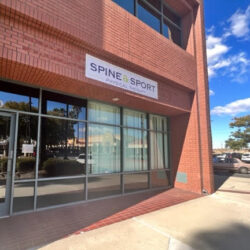The basics of physical therapy evaluation of patients and the physical therapy equipment we use in treatment plans
- At Spine & Sport each team of physical therapists uses a variety of evaluations and rehabilitation equipment to address patients’ needs.
- Depending on the individual patient’s issue or injury, during the initial physical therapy evaluation the physical therapist will conduct a physical exam, appraise the patient’s strength, take range of motion measurements, and test his or her functional mobility and balance.
- The physical therapy (PT) assessment will determine the PT equipment we use to achieve the results of the treatment plan.
- Spine & Sport locations offer a variety of services and equipment. The following physical therapy evaluations and devices are available at all our locations.
Move forward, faster, fearlessly
The Spine & Sport Physical Therapy evaluation
We perform a thorough physical therapy evaluation on each patient at the first appointment. During this assessment our physical therapists will start off by having a thorough discussion with the patient including general medical history, specific history of the injury or condition, and noting the signs and symptoms the patient is experiencing. After the therapist has a good understanding of what the patient has been experiencing, the therapist will then start the physical examination to determine what needs to be addressed in therapy.
Regardless of condition or injury, our physical therapists use objective evaluations and measurements to determine a patient’s activity/movement baseline, help guide treatment plans, set patient goals, provide measurable benchmarks on specific conditions, and to further motivate a patient. A follow-up examination will be completed at least once a month to measure the patient’s progress toward his or her goals.
Following are the types of physical therapy evaluations we use.
McKenzie method of mechanical diagnosis and therapy (MDT)
The McKenzie method involves four steps.
- Assessment.
- Classification.
- Treatment.
- Prevention.
The assessment starts with a detailed history. During the assessment, the patient is asked to carefully repeat or hold certain movements/activities while the physical therapist observes. Having the patient repeat a movement is one of the key differences between a McKenzie evaluation and other physical therapy assessments.
After completing the assessment, the physical therapists at Spine & Sport will determine the patient’s treatment classification. There are three types of classifications for the McKenzie method that help physical therapists design the proper level of activity for each individual.
Our physical therapists partner with each patient to develop a treatment plan. Using the McKenzie method, therapists use information gathered during the assessment and classification steps to instruct patients on proper posture and prescribe specific exercise.
The final step in the McKenzie method is prevention. By encouraging patients to “self-treat” through maintaining their exercise and other self-maintenance programs, the McKenzie method puts patients in control of their recovery. For example, research shows that an active treatment plan is more likely to result in the resolution of a disc problem than an inactive treatment plan.
Multidimensional task ability profile (MTAP)
A computer-based, patient-reported outcome questionnaire, the MTAP identifies functional limitations and the effect of these limitations on one’s ability to work, perform daily tasks and participate in community activities. The MTAP monitors progress, helps in the treatment plan, and improves outcomes through test and retest.
MTAP can be used as an educational tool and help to identify necessary work restrictions or activities of daily life (ADL) that are problematic for the patient.
Spine & Sport Physical Therapy clinics offering MTAP
Objective measurement testing & rehab
Objective measurement testing can be used to determine a patient’s activity/movement baseline. A physical therapist can use objective measurements to help guide treatment plans, set patient goals, provide measurable benchmarks on specific conditions and to further motivate a patient.
Our therapists have hundreds of different tests that can be used in evaluation, depending on the specific patient and issue. For example, it is commonplace for physical therapists to use the following outcome measurement tools.
- Strength and range of motion testing.
- Balance testing.
- Functional movement screening.
- Plank core endurance test.
- Biering-Sorenson test.
- Timed Up and Go (TUG) test.
- 6-minute walk test.
- Functional reach test.
- Semmes-Weinstein test for sensation.
- Questionnaires specific to the body part being treated.
Physical therapy equipment
Physical therapy equipment can be many things, from a simple dumbbell weight to technologically advanced devices specialized for physical therapy. Standard equipment includes:
- Treatment tables, step stools, wedges and supports to keep you comfortable while you are in the clinic.
- Fitness and exercise equipment such as free weights, resistance bands, cable columns, treadmills, balance boards and sports performance equipment.
- Modalities are utilized to create a physiological response that can improve pain and mobility. These include electrical stimulation, traction, cold/heat, and vasopneumatic compression.
More advanced physical therapy equipment follows.
BackStrong
This machine isolates back extensor musculature and precisely strengthens the back extensors. The BackStrong is a Roman chair with six adjustable angles and varied positions for user height. BackStrong’s design was inspired by research conducted by Spine & Sports founder Dr. Vert Mooney.
What conditions & injuries does BackStrong address?
Like its name implies, BackStrong is designed to help patients strengthen the muscles in their back. This piece of physical therapy equipment is specifically geared toward helping patients strengthen their lower and mid back. Patients can experience relief from chronic back pain in just a few weeks.
Spine & Sport Physical Therapy clinics offering BackStrong
MedX exercise equipment
MedX technologically advanced fitness and rehabilitation equipment utilizes low friction and precise biomechanical positioning for optimal results. The MedX is specifically designed to be adjusted in small weight increments ensuring that the weight is just right for steady progress. It is safer than any machinery that you will be able to find in a gym.
What conditions & injuries does MedX address?
MedX equipment is designed to provide relief from headaches as well as chronic neck and back pain by isolating the spinal structure and supporting tissue through isolated strengthening exercises.
Many of our Southern California clinics offer MedX exercise equipment.
What to expect during your physical therapy evaluation appointment
All Spine & Sport therapists are thoroughly trained on evaluation techniques and use of the equipment offered at Spine & Sport. Our staff will work closely with each patient during the initial assessment and through the subsequent appointments.
Patients are provided with instructions on how to use all rehabilitation devices at our clinics. Our physical therapists assist patients throughout their appointment, ensuring that they are properly using our rehabilitation equipment.
Get informed
-
Regaining movement, easing pain and improving quality of life – these are just a few of
the benefits of physical therapy. Learn how PT can help you.

 South San Diego County
South San Diego County Central San Diego County
Central San Diego County East San Diego County
East San Diego County North San Diego County
North San Diego County Orange County
Orange County Imperial County
Imperial County Coachella Valley
Coachella Valley Riverside County
Riverside County Ventura County
Ventura County Los Angeles County
Los Angeles County Northern California
Northern California